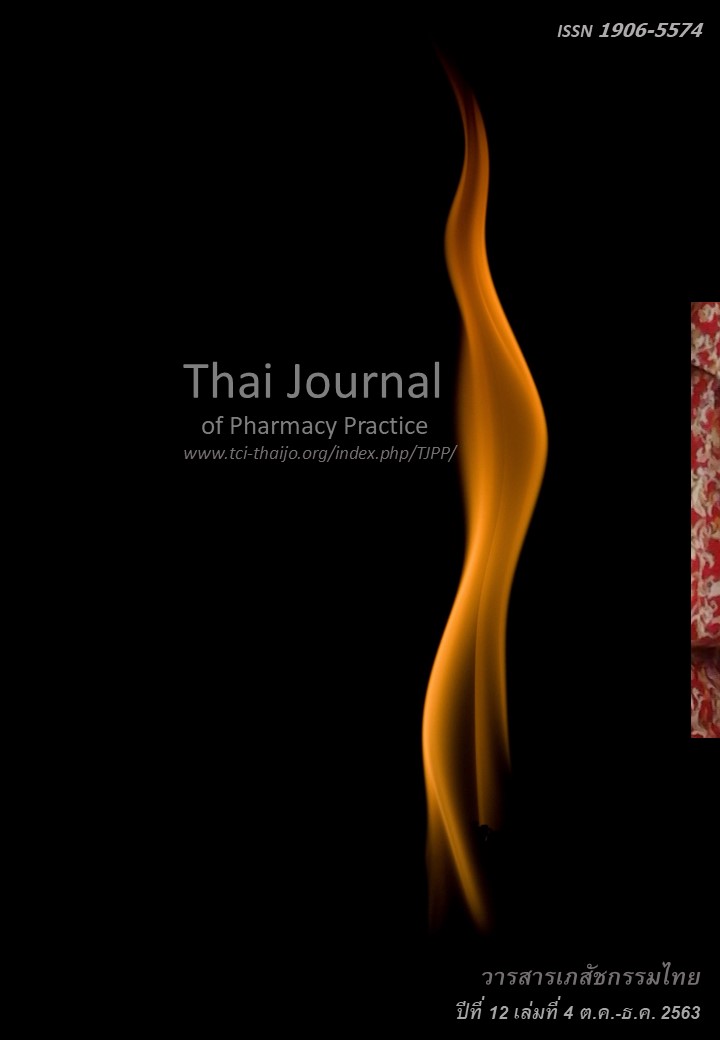ผลกระทบของอันตรกิริยาของยาในกลุ่ม proton pump inhibitor ต่อความผันแปรภายในบุคคลของสัดส่วนความเข้มข้นต่ำสุดต่อขนาดยา tacrolimus ในผู้ปลูกถ่ายไตชาวไทย
Main Article Content
บทคัดย่อ
วัตถุประสงค์: เพื่อเปรียบเทียบค่าความผันแปรภายในบุคคลของสัดส่วนความเข้มข้นต่ำสุดต่อขนาดยา tacrolimus (IPV% ของ C0/dose) ในช่วงเวลา 6–12 เดือนหลังปลูกถ่ายไตระหว่างกลุ่มผู้ป่วยที่มีการเปลี่ยนแปลงการได้รับยาในกลุ่ม proton pump inhibitor (PPI) กับกลุ่มผู้ป่วยที่ไม่ได้รับยา PPI หรือไม่มีการเปลี่ยนแปลงการได้รับยากลุ่ม PPI ในขณะติดตามผลการรักษา วิธีการ: การศึกษารวบรวมข้อมูลย้อนหลังของผู้ป่วยชาวไทยที่ได้รับการปลูกถ่ายไตที่โรงพยาบาลจุฬาลงกรณ์ ตั้งแต่เดือน มกราคม พ.ศ. 2554 ถึง มิถุนายน พ.ศ. 2560 ที่ได้รับยา tacrolimus ในสูตรยากดภูมิคุ้มกัน ผู้วิจัยคำนวณหาค่า IPV% ของ C0/dose ของผู้ป่วยแต่ละรายจากผลการตรวจเลือดในคลินิกปฏิบัติ 3 ค่าที่วัดในเดือนที่ 6, 9 และ 12 หลังปลูกถ่ายไต ผลการวิจัย: ผู้ป่วยปลูกถ่ายไตที่อยู่ในสภาวะคงที่ 201 คน มีค่ามัธยฐาน (พิสัยควอไทล์) IPV% ของ C0/dose ในช่วงเวลา 6-12 เดือนหลังการปลูกถ่ายไตเท่ากับร้อยละ 12.19 (7.61-18.45) ผู้ป่วยที่มีการเปลี่ยนแปลงการได้รับยากลุ่ม PPI 32 คน (ร้อยละ 15.92) มี IPV% ของ C0/dose สูงกว่าผู้ป่วยที่ไม่ได้รับหรือไม่มีการเปลี่ยนแปลงการได้รับยากลุ่ม PPI อย่างมีนัยสำคัญ (ร้อยละ 15.96 (10.89-20.82) เทียบกับ 11.16 (7.41-17.88) ตามลำดับ, P = 0.005) สรุป: IPV% ของ C0/dose ของ tacrolimus ในช่วง 6-12 เดือน หลังการปลูกถ่ายไตของผู้ป่วยที่มีการเปลี่ยนแปลงการได้รับยากลุ่ม PPI สูงกว่ากลุ่มที่ไม่ได้รับหรือไม่มีการเปลี่ยนแปลงอย่างมีนัยสำคัญทางสถิติ ดังนั้น ควรติดตามระดับยาในเลือดและปรับขนาดยา tacrolimus อย่างเหมาะสมในผู้ป่วยที่มีการเปลี่ยนแปลงการได้รับยา PPI
Article Details
ผลการวิจัยและความคิดเห็นที่ปรากฏในบทความถือเป็นความคิดเห็นและอยู่ในความรับผิดชอบของผู้นิพนธ์ มิใช่ความเห็นหรือความรับผิดชอบของกองบรรณาธิการ หรือคณะเภสัชศาสตร์ มหาวิทยาลัยสงขลานครินทร์ ทั้งนี้ไม่รวมความผิดพลาดอันเกิดจากการพิมพ์ บทความที่ได้รับการเผยแพร่โดยวารสารเภสัชกรรมไทยถือเป็นสิทธิ์ของวารสารฯ
เอกสารอ้างอิง
Johnson HJ, Schonder KS. Solid-organ transplantation. In: Dipiro JT, Talbert RL, Yee GC, Matzke GR, Wells BG, Posey LM, editors. Pharmacotherapy. 8th ed. New York: McGraw-Hill; 2011. p. 1547-58.
Quan DJ, Winter ME. Immunosuppressant: cyclosporin, tacrolimus, and sirolimus. In: Winter ME, editor. Basic clinical pharmacokinetics. 5th ed. Philadelphia: Lippincott Williams & Wilkins; 2010. p. 250-76.
Pashaee N, Bouamar R, Hesselink DA, Roodnat JI, van Schaik RH, Weimar W, et al. CYP3A5 genotype is not related to the intrapatient variability of tacrolimus clearance. Ther Drug Monit 2011;33:369-71.
Spierings N, Holt DW, MacPhee IA. CYP3A5 genotype had no impact on intrapatient variability of tacrolimus clearance in renal transplant recipients. Ther Drug Monit 2013;35:328-31.
Borra LC, Roodnat JI, Kal JA, Mathot RA, Weimar W, van Gelder T. High within-patient variability in the clearance of tacrolimus is a risk factor for poor long-term outcome after kidney transplantation. Nephrol Dial Transplant 2010;25:2757-63.
Hsiau M, Fernandez HE, Gjertson D, Ettenger RB, Tsai EW. Monitoring nonadherence and acute rejection with variation in blood immunosuppres- sant levels in pediatric renal transplantation. Transplantation 2011; 92: 918-22.
Ro H, Min SI, Yang J, Moon KC, Kim YS, Kim SJ, et al. Impact of tacrolimus intraindividual variability and CYP3A5 genetic polymorphism on acute rejection in kidney transplantation. Ther Drug Monit 2012; 34: 680-5.
O'Regan JA, Canney M, Connaughton DM, O'Kelly P, Williams Y, Collier G, et al. Tacrolimus trough-level variability predicts long-term allograft survival following kidney transplantation. J Nephrol 2016; 29 : 269-76.
Rodrigo E, Segundo DS, Fernandez-Fresnedo G, Lopez-Hoyos M, Benito A, Ruiz JC, et al. Within-patient variability in tacrolimus blood levels predicts kidney graft loss and donor-specific antibody development. Transplantation 2016; 100: 2479-85.
Whalen HR, Glen JA, Harkins V, Stevens KK, Jardine AG, Geddes CC, et al. High intrapatient tacrolimus variability is associated with worse outcomes in renal transplantation using a low-dose tacrolimus immunosuppressive regime. Transplanta tion 2017; 101: 430-6.
Shuker N, Shuker L, van Rosmalen J, Roodnat JI, Borra LC, Weimar W, et al. A high intrapatient variability in tacrolimus exposure is associated with poor long-term outcome of kidney transplantation. Transpl Int 2016; 29: 1158-67.
Vanhove T, Vermeulen T, Annaert P, Lerut E, Kuypers DRJ. High Intrapatient Variability of tacrolimus concentrations predicts accelerated progression of chronic histologic lesions in renal recipients. Am J Transplant 2016;16:2954-63.
Shuker N, van Gelder T, Hesselink DA. Intra-patient variability in tacrolimus exposure: causes, consequences for clinical management. Transplant Rev (Orlando) 2015;29:78-84.
Bauer LA. Applied clinical pharmacokinetics. 3rd ed. New York: Mcgraw-Hill Education; 2014.
Snyder BD, Polasek TM, Doogue MP. Drug interaction: principles and practice. Aust Prescr 2012; 35: 85-8.
Wells BG, Dipiro JT, Schwinghammer TL, Dipiro CV. Pharmacotherapy handbook. 9th ed. New York : McGraw-Hill; 2015.
Tatro DS. Drug interaction facts 2015. St. Louis, Missouri: Wolter Kluwer Health; 2015.
Takahashi K, Yano I, Fukuhara Y, Katsura T, Takahashi T, Ito N, et al. Distinct effects of omeprazole and rabeprazole on the tacrolimus blood concentration in a kidney transplant recipient. Drug Metab Pharmacokinet 2007;22:441-4.
Lapcharoen P, Vadcharavivad S.Influence of significant level 2 drug interaction on intra-patient variability of tacrolimus blood concentrations in Thai kidney transplant recipients.Thai Journal of Pharmacy Practice 2017;9:27-38
Abbott laboratories. ARCHITECT iSystem: tacroli mus [manufacturer' s information]. USA 2015.
Andersson T.Pharmacokinetics, metabolism and interactions of acid pump inhibitors. Focus on omeprazole, lansoprazole and pantoprazole. Clin Pharmacokinet 1996;31:9-28.
Ishizaki T, Horai Y. Cytochrome P450 and the metabolism of proton pump inhibitors--emphasis on rabeprazole. Aliment Pharmacol Ther 1999;13:27-36.
Pauli-Magnus C, Rekersbrink S, Klotz U, Fromm MF. Interaction of omeprazole, lansoprazole and pantoprazole with P-glycoprotein. Naunyn Schmie debergs Arch Pharmacol 2001;364:551-7.
Zhao W, Fakhoury M, Maisin A, Baudouin V, Storme T, Deschenes G, et al. Pharmacogenetic determinant of the drug interaction between tacrolimus and omeprazole. Ther Drug Monit. 2012; 34: 739-41.
Hosohata K, Masuda S, Ogura Y, Oike F, Takada Y, Katsura T, et al. Interaction between tacrolimus and lansoprazole, but not rabeprazole in living-donor liver transplant patients with defects of CYP2C19 and CYP3A5. Drug Metab Pharmacoki net 2008; 23: 134-8.
Goldstein JA, Ishizaki T, Chiba K, de Morais SM, Bell D, Krahn PM, et al. Frequencies of the defective CYP2C19 alleles responsible for the mephenytoin poor metabolizer phenotype in various Oriental, Caucasian, Saudi Arabian and American black populations. Pharmacogenetics 1997; 7: 59-64.
Kubota T, Chiba K, Ishizaki T. Genotyping of S-mephenytoin 4'-hydroxylation in an extended Japanese population. Clin Pharmacol Ther 1996; 60: 661-6.
Tassaneeyakul W, Mahatthanatrakul W, Niwatana nun K, Na-Bangchang K, Tawalee A, Krikreangsak N, et al. CYP2C19 genetic polymorphism in Thai, Burmese and Karen populations.Drug Metab Phar macokinet 2006;21:286-90.


